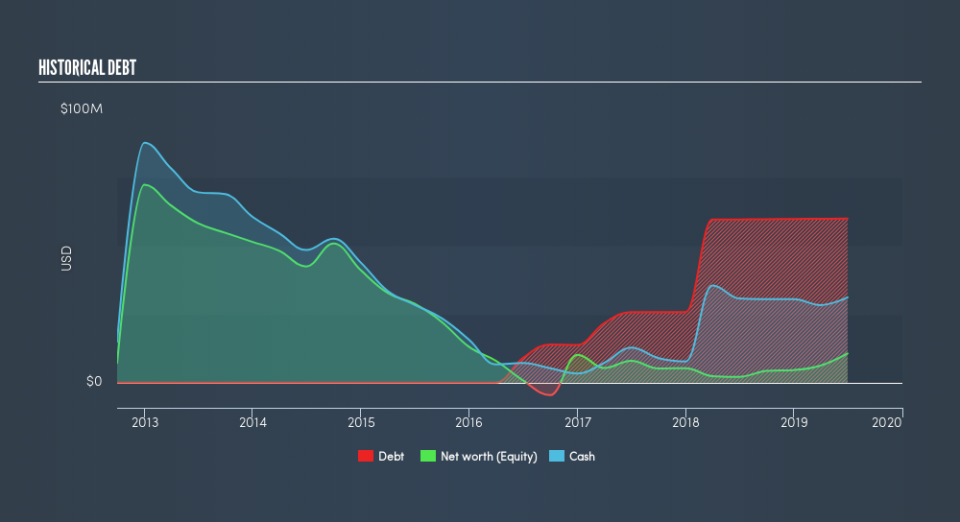We Think Veloxis Pharmaceuticals (CPH:VELO) Is Taking Some Risk With Its Debt

Legendary fund manager Li Lu (who Charlie Munger backed) once said, 'The biggest investment risk is not the volatility of prices, but whether you will suffer a permanent loss of capital.' It's only natural to consider a company's balance sheet when you examine how risky it is, since debt is often involved when a business collapses. We note that Veloxis Pharmaceuticals A/S (CPH:VELO) does have debt on its balance sheet. But the real question is whether this debt is making the company risky.
When Is Debt Dangerous?
Generally speaking, debt only becomes a real problem when a company can't easily pay it off, either by raising capital or with its own cash flow. Ultimately, if the company can't fulfill its legal obligations to repay debt, shareholders could walk away with nothing. While that is not too common, we often do see indebted companies permanently diluting shareholders because lenders force them to raise capital at a distressed price. Of course, plenty of companies use debt to fund growth, without any negative consequences. The first thing to do when considering how much debt a business uses is to look at its cash and debt together.
Check out our latest analysis for Veloxis Pharmaceuticals
What Is Veloxis Pharmaceuticals's Net Debt?
The chart below, which you can click on for greater detail, shows that Veloxis Pharmaceuticals had US$60.1m in debt in June 2019; about the same as the year before. However, it also had US$31.2m in cash, and so its net debt is US$28.8m.
How Healthy Is Veloxis Pharmaceuticals's Balance Sheet?
The latest balance sheet data shows that Veloxis Pharmaceuticals had liabilities of US$16.3m due within a year, and liabilities of US$60.5m falling due after that. On the other hand, it had cash of US$31.2m and US$12.9m worth of receivables due within a year. So its liabilities outweigh the sum of its cash and (near-term) receivables by US$32.8m.
Given Veloxis Pharmaceuticals has a market capitalization of US$898.8m, it's hard to believe these liabilities pose much threat. Having said that, it's clear that we should continue to monitor its balance sheet, lest it change for the worse.
We use two main ratios to inform us about debt levels relative to earnings. The first is net debt divided by earnings before interest, tax, depreciation, and amortization (EBITDA), while the second is how many times its earnings before interest and tax (EBIT) covers its interest expense (or its interest cover, for short). Thus we consider debt relative to earnings both with and without depreciation and amortization expenses.
Weak interest cover of 0.28 times and a disturbingly high net debt to EBITDA ratio of 13.3 hit our confidence in Veloxis Pharmaceuticals like a one-two punch to the gut. This means we'd consider it to have a heavy debt load. One redeeming factor for Veloxis Pharmaceuticals is that it turned last year's EBIT loss into a gain of US$1.8m, over the last twelve months. When analysing debt levels, the balance sheet is the obvious place to start. But it is future earnings, more than anything, that will determine Veloxis Pharmaceuticals's ability to maintain a healthy balance sheet going forward. So if you want to see what the professionals think, you might find this free report on analyst profit forecasts to be interesting.
Finally, a company can only pay off debt with cold hard cash, not accounting profits. So it's worth checking how much of the earnings before interest and tax (EBIT) is backed by free cash flow. During the last year, Veloxis Pharmaceuticals burned a lot of cash. While investors are no doubt expecting a reversal of that situation in due course, it clearly does mean its use of debt is more risky.
Our View
On the face of it, Veloxis Pharmaceuticals's interest cover left us tentative about the stock, and its conversion of EBIT to free cash flow was no more enticing than the one empty restaurant on the busiest night of the year. But at least it's pretty decent at staying on top of its total liabilities; that's encouraging. Looking at the balance sheet and taking into account all these factors, we do believe that debt is making Veloxis Pharmaceuticals stock a bit risky. Some people like that sort of risk, but we're mindful of the potential pitfalls, so we'd probably prefer it carry less debt. Over time, share prices tend to follow earnings per share, so if you're interested in Veloxis Pharmaceuticals, you may well want to click here to check an interactive graph of its earnings per share history.
If, after all that, you're more interested in a fast growing company with a rock-solid balance sheet, then check out our list of net cash growth stocks without delay.
We aim to bring you long-term focused research analysis driven by fundamental data. Note that our analysis may not factor in the latest price-sensitive company announcements or qualitative material.
If you spot an error that warrants correction, please contact the editor at editorial-team@simplywallst.com. This article by Simply Wall St is general in nature. It does not constitute a recommendation to buy or sell any stock, and does not take account of your objectives, or your financial situation. Simply Wall St has no position in the stocks mentioned. Thank you for reading.

